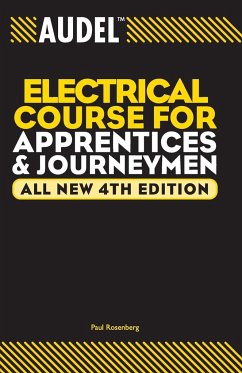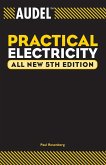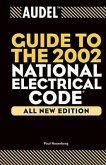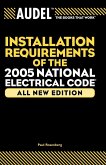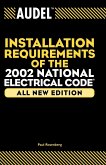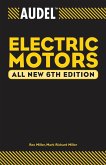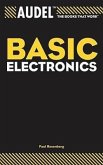Paul Rosenberg
Audel Electrical Course for Apprentices and Journeymen
Paul Rosenberg
Audel Electrical Course for Apprentices and Journeymen
- Broschiertes Buch
- Merkliste
- Auf die Merkliste
- Bewerten Bewerten
- Teilen
- Produkt teilen
- Produkterinnerung
- Produkterinnerung
Spend your study time wisely As you advance from student to apprentice to journeyman status, you log a lot of study hours. Make the most of those hours with this fully updated, sharply focused self-study course. It contains everything you need to know about electrical theory and applications, clearly defined and logically organized, with illustrations for clarity and review questions at the end of each chapter to help you test your knowledge. * Understand electron theory and how electricity affects matter * Recognize applications for both alternating and direct current * Comprehend Ohms Law…mehr
Andere Kunden interessierten sich auch für
![Audel Practical Electricity Audel Practical Electricity]() Paul RosenbergAudel Practical Electricity54,99 €
Paul RosenbergAudel Practical Electricity54,99 €![Audel Guide to the 2002 National Electrical Code Audel Guide to the 2002 National Electrical Code]() Paul RosenbergAudel Guide to the 2002 National Electrical Code75,99 €
Paul RosenbergAudel Guide to the 2002 National Electrical Code75,99 €![Audel Installation Requirements of the 2005 National Electrical Code Audel Installation Requirements of the 2005 National Electrical Code]() Paul RosenbergAudel Installation Requirements of the 2005 National Electrical Code36,99 €
Paul RosenbergAudel Installation Requirements of the 2005 National Electrical Code36,99 €![Installation Requirements of the 2002 National Electrical Code Installation Requirements of the 2002 National Electrical Code]() Paul RosenbergInstallation Requirements of the 2002 National Electrical Code40,99 €
Paul RosenbergInstallation Requirements of the 2002 National Electrical Code40,99 €![Audel Electric Motors Audel Electric Motors]() Rex MillerAudel Electric Motors65,99 €
Rex MillerAudel Electric Motors65,99 €![Audel House Wiring Audel House Wiring]() Paul RosenbergAudel House Wiring47,99 €
Paul RosenbergAudel House Wiring47,99 €![Audel Basic Electronics Audel Basic Electronics]() Paul RosenbergAudel Basic Electronics33,99 €
Paul RosenbergAudel Basic Electronics33,99 €-
-
-
Spend your study time wisely As you advance from student to apprentice to journeyman status, you log a lot of study hours. Make the most of those hours with this fully updated, sharply focused self-study course. It contains everything you need to know about electrical theory and applications, clearly defined and logically organized, with illustrations for clarity and review questions at the end of each chapter to help you test your knowledge. * Understand electron theory and how electricity affects matter * Recognize applications for both alternating and direct current * Comprehend Ohms Law and the laws governing magnetic circuits * Learn from detailed drawings and diagrams * Explore trigonometry and alternative methods of calculation * Identify instruments and measurements used in electrical applications * Apply proper grounding and ground testing, insulation testing, and power factor correction
Hinweis: Dieser Artikel kann nur an eine deutsche Lieferadresse ausgeliefert werden.
Hinweis: Dieser Artikel kann nur an eine deutsche Lieferadresse ausgeliefert werden.
Produktdetails
- Produktdetails
- Verlag: Wiley
- 4th All New 4th edition
- Seitenzahl: 432
- Erscheinungstermin: 2. April 2004
- Englisch
- Abmessung: 216mm x 140mm x 23mm
- Gewicht: 541g
- ISBN-13: 9780764542008
- ISBN-10: 0764542001
- Artikelnr.: 21397302
- Herstellerkennzeichnung
- Libri GmbH
- Europaallee 1
- 36244 Bad Hersfeld
- gpsr@libri.de
- Verlag: Wiley
- 4th All New 4th edition
- Seitenzahl: 432
- Erscheinungstermin: 2. April 2004
- Englisch
- Abmessung: 216mm x 140mm x 23mm
- Gewicht: 541g
- ISBN-13: 9780764542008
- ISBN-10: 0764542001
- Artikelnr.: 21397302
- Herstellerkennzeichnung
- Libri GmbH
- Europaallee 1
- 36244 Bad Hersfeld
- gpsr@libri.de
Paul Rosenberg is a master electrician with extensive experience in all aspects of the industry. An instructor at Iowa State University, he has written for all the major electrical industry publications. He is also the author of Audel Questions and Answers for Electrician's Examinations, 14th Edition.
Introduction xiii
Chapter 1 Electricity and Matter 1
Elements, Atoms, Molecules, and Compounds 1
Electron Theory 3
Electric Current 9
Insulators and Conductors 11
Questions 12
Chapter 2 Units and Definitions 13
Fundamental and Derived Units 13
Definitions 15
Magnetic Units 17
Temperature Units 18
Questions 18
Chapter 3 Electrical Symbols 21
Graphic Electrical Wiring Symbols 21
0.1 Drafting Practices Applicable to Graphic Electrical Wiring Symbols 21
0.2 Explanation Supplementing the Schedule of Symbols 23
List of Symbols 27
1.0 Lighting Outlets 27
2.0 Receptacle Outlets 28
3.0 Switch Outlets 31
4.0 Signaling System Outlets: Institutional, Commercial, and Industrial
Occupancies 31
5.0 Signaling System Outlets: Residential Occupancies 36
6.0 Panelboards, Switchboards, and Related Equipment 37
7.0 Bus Ducts and Wireways 38
8.0 Remote Control Stations for Motors or Other Equipment* 39
9.0 Circuiting 39
10.0 Electric Distribution or Lighting System, Underground 40
11.0 Electric Distribution or Lighting System Aerial 41
Arrester, Lightning Arrester (Electric Surge, etc.) Gap 42
Battery 43
Circuit Breakers 43
Circuit Return 45
Coil, Magnetic Blowout* 45
Contact, Electrical 46
Contactor 48
Machine, Rotating 49
Meter Instrument 53
Path, Transmission, Conductor, Cable Wiring 55
Polarity Symbol 56
Switch 57
Transformer 58
Chapter 4 Magnets and Magnetic Fields 63
Magnetic Poles 63
Magnetic and Nonmagnetic Substances 64
The Earth as Magnet 64
Magnetic Lines of Force 65
Molecular Theory of Magnetism 66
Strength of a Magnet 68
Lifting Power of a Magnet 68
Questions 69
Chapter 5 Ohm's Law 71
Statement of Ohm's Law 71
Analogy of Ohm's Law 71
Illustrations of Ohm's Law 72
Ohm's Law and Power 74
The Ohm's Law Circle 74
Formulas 75
Ohm's Law 75
Power in Watts 75
Questions 76
Chapter 6 Capacitors 77
Capacitance 83
Capacitance in Series and Parallel 84
Capacitance in Other Than Regular Capacitors 86
Formulas 87
Questions 87
Chapter 7 Resistance 89
Skin Effect 97
Conductivity 97
Voltage-Drop Calculation 99
Measuring Conductors 100
Questions 101
Chapter 8 Resistance in Series and Parallel 103
Resistances in Series 103
Resistances in Parallel 104
Series-Parallel Circuits 107
Questions 109
Chapter 9 Electrolysis 111
Terminology 111
Chemistry of Electrolysis 112
Electroplating 114
Corrosion 114
Questions 116
Chapter 10 Primary and Secondary Cells 117
The Voltaic Cell 117
Primary Cells 119
Secondary Cells 122
Questions 127
Chapter 11 Electromagnetism 129
Galvanoscope 134
Solenoids 135
Questions 136
Chapter 12 Laws Governing Magnetic Circuits 139
Strength of a Magnetic Pole 141
Intensity of Magnetizing Force 142
Magnetic Reluctance 142
Formulas 149
Questions 149
Chapter 13 Work, Power, Energy, Torque, and Efficiency 151
Torque 155
Prony Brake 156
Formulas 158
Questions 158
Chapter 14 Instruments and Measurements 161
Voltmeters and Ammeters 163
Edison Pendulum Ammeter 163
Battery Gauge 164
Indicating Wattmeter 165
Ohmmeters 168
Thermostats 169
Thermocouples 169
Questions 170
Chapter 15 Insulation Testing 171
Test Voltages vs. Equipment Ratings 172
Cables and Conductors 174
Conductors in Parallel 181
Effect of Temperature on Insulation Resistance* 185
Questions 185
Chapter 16 Electromagnetic Induction 187
Basic Principles 187
Lenz's Law 188
Fleming's Rule 192
Mutual Induction 192
Eddy Currents 194
Questions 195
Chapter 17 Alternating Currents 197
Advantages of AC 197
Generation of AC 197
AC Sine Wave 201
Paralleling Alternators 203
Formulas 204
Questions 204
Chapter 18 DC Generators 207
Generators vs. Alternators 207
Generation of EMF 207
Armatures 208
Brushes 211
Types of Generators 212
Generator Voltage Control 214
Questions 214
Chapter 19 DC Motors 215
Armature Movement 215
DC Motors vs. DC Generators 215
Regulation of DC Motors 216
Starting the DC Motor 220
Reversing Motor Direction 220
Questions 221
Chapter 20 Inductance and Reactance 223
Inductance 223
Inductive Reactance 223
Impedance 224
Effects of Circuit Inductance 225
Phase Angle 226
True Power and Power Factor 229
Worked Examples 230
Formulas 232
Questions 233
Chapter 21 Capacitance in AC Circuits 235
Analogy of Capacitor Action 235
Capacitor Action 236
Capacitance 236
Current and Voltage Relations 237
Capacitive Reactance 238
Inductive and Capacitive Circuits 238
Formulas 241
Questions 241
Chapter 22 Resistance, Capacitance, and Inductance in Series and Parallel
243
RC Circuit 243
RLC Circuit 244
Parallel LC Circuit 248
Resonance 249
System Power Factor 251
Formulas 253
Questions 253
Chapter 23 Polyphase Circuits 255
Multiphase Systems 255
Two-Phase Systems 255
Three-Phase Systems 257
Questions 261
Chapter 24 Power in Polyphase Circuits 263
Three-Phase Wye Connection 264
Three-Phase Delta Connection 266
Economy and Phases 268
Neutral Current in Three-Phase, Four-Wire Systems 269
Formulas 273
Questions 274
Chapter 25 Transformer Principles 277
Induction Coil 277
Transformer Types 279
Principles of Operation 280
Windings and Voltages 281
Formulas 284
Questions 284
Chapter 26 Transformer Facts 285
Transformer Impedance 287
Transformers in Parallel 289
Transformer Insulation 289
Types of Transformers 290
Effects of Altitudes 290
Ambient Temperature 290
Transformer Polarity 291
Termination Marking 292
Formulas 293
Questions 294
Chapter 27 Transforming Polyphase Power 295
Single-Phase for Three-Phase 295
Three-Phase Transformers 297
Two-Phase to Three-Phase Conversion 299
Delta- and Wye-Connection Voltages and Currents 301
Questions 302
Chapter 28 Autotransformers 303
Autotransformers and Conventional Transformers 303
Induction Voltage Regulator 304
Transformer Booster 305
Questions 306
Chapter 29 Instrument Transformers 307
Use of Instrument Transformers 307
Types of Instrument Transformers 307
Potential Transformers 308
Current Transformers 309
Ratings 309
Opening the Secondary Circuit 309
Symbols 310
Ground Fault Protection 310
Questions 312
Chapter 30 Polyphase Induction Motors 313
Rotating Magnetic Field 313
Squirrel Cage Rotor Winding 316
Wound Rotors 320
Dual Voltages 320
Induction Motors on Start 324
Altitude Correction 326
Power Factor 326
Questions 328
Chapter 31 Power-Factor Correction 329
Reactive Kilovolt-Amperes 329
Use of Correction Table 329
Correction with Capacitors 331
Use of Chart 331
Use of Mathematics 332
Overloads 335
Reasons for Corrections 335
Questions 336
Chapter 32 Synchronous Motors 337
Characteristics 337
Operation 337
Power Factor 339
Regulation 340
Questions 342
Chapter 33 Single-Phase Motors 343
Phase Splitting 343
Shading-Coil Motors 344
Universal Motors 345
Hysteresis Motors 345
Split-Phase Induction Motor 345
Capacitor-Start Motors 347
Capacitor-Start, Capacitor-Run Motor 347
Repulsion Motors 348
Repulsion-Induction Motors 350
Questions 351
Chapter 34 Grounding and Ground Testing 353
Grounding Requirements 353
Conduction in Soil 354
Grounding Electrode 356
Fall-of-Potential Method 356
System Grounding 362
Questions 366
Chapter 35 Rectifiers 367
Mercury-Arc Rectifier 367
Dry-Contact Rectifiers 368
Solid-State Rectifiers 370
Rectifier Connections 371
Questions 373
Chapter 36 Number of Bends in Conduit 375
Chapter 37 Torque Test for Bolts and Screws 381
Appendix 383
Index 391
Chapter 1 Electricity and Matter 1
Elements, Atoms, Molecules, and Compounds 1
Electron Theory 3
Electric Current 9
Insulators and Conductors 11
Questions 12
Chapter 2 Units and Definitions 13
Fundamental and Derived Units 13
Definitions 15
Magnetic Units 17
Temperature Units 18
Questions 18
Chapter 3 Electrical Symbols 21
Graphic Electrical Wiring Symbols 21
0.1 Drafting Practices Applicable to Graphic Electrical Wiring Symbols 21
0.2 Explanation Supplementing the Schedule of Symbols 23
List of Symbols 27
1.0 Lighting Outlets 27
2.0 Receptacle Outlets 28
3.0 Switch Outlets 31
4.0 Signaling System Outlets: Institutional, Commercial, and Industrial
Occupancies 31
5.0 Signaling System Outlets: Residential Occupancies 36
6.0 Panelboards, Switchboards, and Related Equipment 37
7.0 Bus Ducts and Wireways 38
8.0 Remote Control Stations for Motors or Other Equipment* 39
9.0 Circuiting 39
10.0 Electric Distribution or Lighting System, Underground 40
11.0 Electric Distribution or Lighting System Aerial 41
Arrester, Lightning Arrester (Electric Surge, etc.) Gap 42
Battery 43
Circuit Breakers 43
Circuit Return 45
Coil, Magnetic Blowout* 45
Contact, Electrical 46
Contactor 48
Machine, Rotating 49
Meter Instrument 53
Path, Transmission, Conductor, Cable Wiring 55
Polarity Symbol 56
Switch 57
Transformer 58
Chapter 4 Magnets and Magnetic Fields 63
Magnetic Poles 63
Magnetic and Nonmagnetic Substances 64
The Earth as Magnet 64
Magnetic Lines of Force 65
Molecular Theory of Magnetism 66
Strength of a Magnet 68
Lifting Power of a Magnet 68
Questions 69
Chapter 5 Ohm's Law 71
Statement of Ohm's Law 71
Analogy of Ohm's Law 71
Illustrations of Ohm's Law 72
Ohm's Law and Power 74
The Ohm's Law Circle 74
Formulas 75
Ohm's Law 75
Power in Watts 75
Questions 76
Chapter 6 Capacitors 77
Capacitance 83
Capacitance in Series and Parallel 84
Capacitance in Other Than Regular Capacitors 86
Formulas 87
Questions 87
Chapter 7 Resistance 89
Skin Effect 97
Conductivity 97
Voltage-Drop Calculation 99
Measuring Conductors 100
Questions 101
Chapter 8 Resistance in Series and Parallel 103
Resistances in Series 103
Resistances in Parallel 104
Series-Parallel Circuits 107
Questions 109
Chapter 9 Electrolysis 111
Terminology 111
Chemistry of Electrolysis 112
Electroplating 114
Corrosion 114
Questions 116
Chapter 10 Primary and Secondary Cells 117
The Voltaic Cell 117
Primary Cells 119
Secondary Cells 122
Questions 127
Chapter 11 Electromagnetism 129
Galvanoscope 134
Solenoids 135
Questions 136
Chapter 12 Laws Governing Magnetic Circuits 139
Strength of a Magnetic Pole 141
Intensity of Magnetizing Force 142
Magnetic Reluctance 142
Formulas 149
Questions 149
Chapter 13 Work, Power, Energy, Torque, and Efficiency 151
Torque 155
Prony Brake 156
Formulas 158
Questions 158
Chapter 14 Instruments and Measurements 161
Voltmeters and Ammeters 163
Edison Pendulum Ammeter 163
Battery Gauge 164
Indicating Wattmeter 165
Ohmmeters 168
Thermostats 169
Thermocouples 169
Questions 170
Chapter 15 Insulation Testing 171
Test Voltages vs. Equipment Ratings 172
Cables and Conductors 174
Conductors in Parallel 181
Effect of Temperature on Insulation Resistance* 185
Questions 185
Chapter 16 Electromagnetic Induction 187
Basic Principles 187
Lenz's Law 188
Fleming's Rule 192
Mutual Induction 192
Eddy Currents 194
Questions 195
Chapter 17 Alternating Currents 197
Advantages of AC 197
Generation of AC 197
AC Sine Wave 201
Paralleling Alternators 203
Formulas 204
Questions 204
Chapter 18 DC Generators 207
Generators vs. Alternators 207
Generation of EMF 207
Armatures 208
Brushes 211
Types of Generators 212
Generator Voltage Control 214
Questions 214
Chapter 19 DC Motors 215
Armature Movement 215
DC Motors vs. DC Generators 215
Regulation of DC Motors 216
Starting the DC Motor 220
Reversing Motor Direction 220
Questions 221
Chapter 20 Inductance and Reactance 223
Inductance 223
Inductive Reactance 223
Impedance 224
Effects of Circuit Inductance 225
Phase Angle 226
True Power and Power Factor 229
Worked Examples 230
Formulas 232
Questions 233
Chapter 21 Capacitance in AC Circuits 235
Analogy of Capacitor Action 235
Capacitor Action 236
Capacitance 236
Current and Voltage Relations 237
Capacitive Reactance 238
Inductive and Capacitive Circuits 238
Formulas 241
Questions 241
Chapter 22 Resistance, Capacitance, and Inductance in Series and Parallel
243
RC Circuit 243
RLC Circuit 244
Parallel LC Circuit 248
Resonance 249
System Power Factor 251
Formulas 253
Questions 253
Chapter 23 Polyphase Circuits 255
Multiphase Systems 255
Two-Phase Systems 255
Three-Phase Systems 257
Questions 261
Chapter 24 Power in Polyphase Circuits 263
Three-Phase Wye Connection 264
Three-Phase Delta Connection 266
Economy and Phases 268
Neutral Current in Three-Phase, Four-Wire Systems 269
Formulas 273
Questions 274
Chapter 25 Transformer Principles 277
Induction Coil 277
Transformer Types 279
Principles of Operation 280
Windings and Voltages 281
Formulas 284
Questions 284
Chapter 26 Transformer Facts 285
Transformer Impedance 287
Transformers in Parallel 289
Transformer Insulation 289
Types of Transformers 290
Effects of Altitudes 290
Ambient Temperature 290
Transformer Polarity 291
Termination Marking 292
Formulas 293
Questions 294
Chapter 27 Transforming Polyphase Power 295
Single-Phase for Three-Phase 295
Three-Phase Transformers 297
Two-Phase to Three-Phase Conversion 299
Delta- and Wye-Connection Voltages and Currents 301
Questions 302
Chapter 28 Autotransformers 303
Autotransformers and Conventional Transformers 303
Induction Voltage Regulator 304
Transformer Booster 305
Questions 306
Chapter 29 Instrument Transformers 307
Use of Instrument Transformers 307
Types of Instrument Transformers 307
Potential Transformers 308
Current Transformers 309
Ratings 309
Opening the Secondary Circuit 309
Symbols 310
Ground Fault Protection 310
Questions 312
Chapter 30 Polyphase Induction Motors 313
Rotating Magnetic Field 313
Squirrel Cage Rotor Winding 316
Wound Rotors 320
Dual Voltages 320
Induction Motors on Start 324
Altitude Correction 326
Power Factor 326
Questions 328
Chapter 31 Power-Factor Correction 329
Reactive Kilovolt-Amperes 329
Use of Correction Table 329
Correction with Capacitors 331
Use of Chart 331
Use of Mathematics 332
Overloads 335
Reasons for Corrections 335
Questions 336
Chapter 32 Synchronous Motors 337
Characteristics 337
Operation 337
Power Factor 339
Regulation 340
Questions 342
Chapter 33 Single-Phase Motors 343
Phase Splitting 343
Shading-Coil Motors 344
Universal Motors 345
Hysteresis Motors 345
Split-Phase Induction Motor 345
Capacitor-Start Motors 347
Capacitor-Start, Capacitor-Run Motor 347
Repulsion Motors 348
Repulsion-Induction Motors 350
Questions 351
Chapter 34 Grounding and Ground Testing 353
Grounding Requirements 353
Conduction in Soil 354
Grounding Electrode 356
Fall-of-Potential Method 356
System Grounding 362
Questions 366
Chapter 35 Rectifiers 367
Mercury-Arc Rectifier 367
Dry-Contact Rectifiers 368
Solid-State Rectifiers 370
Rectifier Connections 371
Questions 373
Chapter 36 Number of Bends in Conduit 375
Chapter 37 Torque Test for Bolts and Screws 381
Appendix 383
Index 391
Introduction xiii
Chapter 1 Electricity and Matter 1
Elements, Atoms, Molecules, and Compounds 1
Electron Theory 3
Electric Current 9
Insulators and Conductors 11
Questions 12
Chapter 2 Units and Definitions 13
Fundamental and Derived Units 13
Definitions 15
Magnetic Units 17
Temperature Units 18
Questions 18
Chapter 3 Electrical Symbols 21
Graphic Electrical Wiring Symbols 21
0.1 Drafting Practices Applicable to Graphic Electrical Wiring Symbols 21
0.2 Explanation Supplementing the Schedule of Symbols 23
List of Symbols 27
1.0 Lighting Outlets 27
2.0 Receptacle Outlets 28
3.0 Switch Outlets 31
4.0 Signaling System Outlets: Institutional, Commercial, and Industrial
Occupancies 31
5.0 Signaling System Outlets: Residential Occupancies 36
6.0 Panelboards, Switchboards, and Related Equipment 37
7.0 Bus Ducts and Wireways 38
8.0 Remote Control Stations for Motors or Other Equipment* 39
9.0 Circuiting 39
10.0 Electric Distribution or Lighting System, Underground 40
11.0 Electric Distribution or Lighting System Aerial 41
Arrester, Lightning Arrester (Electric Surge, etc.) Gap 42
Battery 43
Circuit Breakers 43
Circuit Return 45
Coil, Magnetic Blowout* 45
Contact, Electrical 46
Contactor 48
Machine, Rotating 49
Meter Instrument 53
Path, Transmission, Conductor, Cable Wiring 55
Polarity Symbol 56
Switch 57
Transformer 58
Chapter 4 Magnets and Magnetic Fields 63
Magnetic Poles 63
Magnetic and Nonmagnetic Substances 64
The Earth as Magnet 64
Magnetic Lines of Force 65
Molecular Theory of Magnetism 66
Strength of a Magnet 68
Lifting Power of a Magnet 68
Questions 69
Chapter 5 Ohm's Law 71
Statement of Ohm's Law 71
Analogy of Ohm's Law 71
Illustrations of Ohm's Law 72
Ohm's Law and Power 74
The Ohm's Law Circle 74
Formulas 75
Ohm's Law 75
Power in Watts 75
Questions 76
Chapter 6 Capacitors 77
Capacitance 83
Capacitance in Series and Parallel 84
Capacitance in Other Than Regular Capacitors 86
Formulas 87
Questions 87
Chapter 7 Resistance 89
Skin Effect 97
Conductivity 97
Voltage-Drop Calculation 99
Measuring Conductors 100
Questions 101
Chapter 8 Resistance in Series and Parallel 103
Resistances in Series 103
Resistances in Parallel 104
Series-Parallel Circuits 107
Questions 109
Chapter 9 Electrolysis 111
Terminology 111
Chemistry of Electrolysis 112
Electroplating 114
Corrosion 114
Questions 116
Chapter 10 Primary and Secondary Cells 117
The Voltaic Cell 117
Primary Cells 119
Secondary Cells 122
Questions 127
Chapter 11 Electromagnetism 129
Galvanoscope 134
Solenoids 135
Questions 136
Chapter 12 Laws Governing Magnetic Circuits 139
Strength of a Magnetic Pole 141
Intensity of Magnetizing Force 142
Magnetic Reluctance 142
Formulas 149
Questions 149
Chapter 13 Work, Power, Energy, Torque, and Efficiency 151
Torque 155
Prony Brake 156
Formulas 158
Questions 158
Chapter 14 Instruments and Measurements 161
Voltmeters and Ammeters 163
Edison Pendulum Ammeter 163
Battery Gauge 164
Indicating Wattmeter 165
Ohmmeters 168
Thermostats 169
Thermocouples 169
Questions 170
Chapter 15 Insulation Testing 171
Test Voltages vs. Equipment Ratings 172
Cables and Conductors 174
Conductors in Parallel 181
Effect of Temperature on Insulation Resistance* 185
Questions 185
Chapter 16 Electromagnetic Induction 187
Basic Principles 187
Lenz's Law 188
Fleming's Rule 192
Mutual Induction 192
Eddy Currents 194
Questions 195
Chapter 17 Alternating Currents 197
Advantages of AC 197
Generation of AC 197
AC Sine Wave 201
Paralleling Alternators 203
Formulas 204
Questions 204
Chapter 18 DC Generators 207
Generators vs. Alternators 207
Generation of EMF 207
Armatures 208
Brushes 211
Types of Generators 212
Generator Voltage Control 214
Questions 214
Chapter 19 DC Motors 215
Armature Movement 215
DC Motors vs. DC Generators 215
Regulation of DC Motors 216
Starting the DC Motor 220
Reversing Motor Direction 220
Questions 221
Chapter 20 Inductance and Reactance 223
Inductance 223
Inductive Reactance 223
Impedance 224
Effects of Circuit Inductance 225
Phase Angle 226
True Power and Power Factor 229
Worked Examples 230
Formulas 232
Questions 233
Chapter 21 Capacitance in AC Circuits 235
Analogy of Capacitor Action 235
Capacitor Action 236
Capacitance 236
Current and Voltage Relations 237
Capacitive Reactance 238
Inductive and Capacitive Circuits 238
Formulas 241
Questions 241
Chapter 22 Resistance, Capacitance, and Inductance in Series and Parallel
243
RC Circuit 243
RLC Circuit 244
Parallel LC Circuit 248
Resonance 249
System Power Factor 251
Formulas 253
Questions 253
Chapter 23 Polyphase Circuits 255
Multiphase Systems 255
Two-Phase Systems 255
Three-Phase Systems 257
Questions 261
Chapter 24 Power in Polyphase Circuits 263
Three-Phase Wye Connection 264
Three-Phase Delta Connection 266
Economy and Phases 268
Neutral Current in Three-Phase, Four-Wire Systems 269
Formulas 273
Questions 274
Chapter 25 Transformer Principles 277
Induction Coil 277
Transformer Types 279
Principles of Operation 280
Windings and Voltages 281
Formulas 284
Questions 284
Chapter 26 Transformer Facts 285
Transformer Impedance 287
Transformers in Parallel 289
Transformer Insulation 289
Types of Transformers 290
Effects of Altitudes 290
Ambient Temperature 290
Transformer Polarity 291
Termination Marking 292
Formulas 293
Questions 294
Chapter 27 Transforming Polyphase Power 295
Single-Phase for Three-Phase 295
Three-Phase Transformers 297
Two-Phase to Three-Phase Conversion 299
Delta- and Wye-Connection Voltages and Currents 301
Questions 302
Chapter 28 Autotransformers 303
Autotransformers and Conventional Transformers 303
Induction Voltage Regulator 304
Transformer Booster 305
Questions 306
Chapter 29 Instrument Transformers 307
Use of Instrument Transformers 307
Types of Instrument Transformers 307
Potential Transformers 308
Current Transformers 309
Ratings 309
Opening the Secondary Circuit 309
Symbols 310
Ground Fault Protection 310
Questions 312
Chapter 30 Polyphase Induction Motors 313
Rotating Magnetic Field 313
Squirrel Cage Rotor Winding 316
Wound Rotors 320
Dual Voltages 320
Induction Motors on Start 324
Altitude Correction 326
Power Factor 326
Questions 328
Chapter 31 Power-Factor Correction 329
Reactive Kilovolt-Amperes 329
Use of Correction Table 329
Correction with Capacitors 331
Use of Chart 331
Use of Mathematics 332
Overloads 335
Reasons for Corrections 335
Questions 336
Chapter 32 Synchronous Motors 337
Characteristics 337
Operation 337
Power Factor 339
Regulation 340
Questions 342
Chapter 33 Single-Phase Motors 343
Phase Splitting 343
Shading-Coil Motors 344
Universal Motors 345
Hysteresis Motors 345
Split-Phase Induction Motor 345
Capacitor-Start Motors 347
Capacitor-Start, Capacitor-Run Motor 347
Repulsion Motors 348
Repulsion-Induction Motors 350
Questions 351
Chapter 34 Grounding and Ground Testing 353
Grounding Requirements 353
Conduction in Soil 354
Grounding Electrode 356
Fall-of-Potential Method 356
System Grounding 362
Questions 366
Chapter 35 Rectifiers 367
Mercury-Arc Rectifier 367
Dry-Contact Rectifiers 368
Solid-State Rectifiers 370
Rectifier Connections 371
Questions 373
Chapter 36 Number of Bends in Conduit 375
Chapter 37 Torque Test for Bolts and Screws 381
Appendix 383
Index 391
Chapter 1 Electricity and Matter 1
Elements, Atoms, Molecules, and Compounds 1
Electron Theory 3
Electric Current 9
Insulators and Conductors 11
Questions 12
Chapter 2 Units and Definitions 13
Fundamental and Derived Units 13
Definitions 15
Magnetic Units 17
Temperature Units 18
Questions 18
Chapter 3 Electrical Symbols 21
Graphic Electrical Wiring Symbols 21
0.1 Drafting Practices Applicable to Graphic Electrical Wiring Symbols 21
0.2 Explanation Supplementing the Schedule of Symbols 23
List of Symbols 27
1.0 Lighting Outlets 27
2.0 Receptacle Outlets 28
3.0 Switch Outlets 31
4.0 Signaling System Outlets: Institutional, Commercial, and Industrial
Occupancies 31
5.0 Signaling System Outlets: Residential Occupancies 36
6.0 Panelboards, Switchboards, and Related Equipment 37
7.0 Bus Ducts and Wireways 38
8.0 Remote Control Stations for Motors or Other Equipment* 39
9.0 Circuiting 39
10.0 Electric Distribution or Lighting System, Underground 40
11.0 Electric Distribution or Lighting System Aerial 41
Arrester, Lightning Arrester (Electric Surge, etc.) Gap 42
Battery 43
Circuit Breakers 43
Circuit Return 45
Coil, Magnetic Blowout* 45
Contact, Electrical 46
Contactor 48
Machine, Rotating 49
Meter Instrument 53
Path, Transmission, Conductor, Cable Wiring 55
Polarity Symbol 56
Switch 57
Transformer 58
Chapter 4 Magnets and Magnetic Fields 63
Magnetic Poles 63
Magnetic and Nonmagnetic Substances 64
The Earth as Magnet 64
Magnetic Lines of Force 65
Molecular Theory of Magnetism 66
Strength of a Magnet 68
Lifting Power of a Magnet 68
Questions 69
Chapter 5 Ohm's Law 71
Statement of Ohm's Law 71
Analogy of Ohm's Law 71
Illustrations of Ohm's Law 72
Ohm's Law and Power 74
The Ohm's Law Circle 74
Formulas 75
Ohm's Law 75
Power in Watts 75
Questions 76
Chapter 6 Capacitors 77
Capacitance 83
Capacitance in Series and Parallel 84
Capacitance in Other Than Regular Capacitors 86
Formulas 87
Questions 87
Chapter 7 Resistance 89
Skin Effect 97
Conductivity 97
Voltage-Drop Calculation 99
Measuring Conductors 100
Questions 101
Chapter 8 Resistance in Series and Parallel 103
Resistances in Series 103
Resistances in Parallel 104
Series-Parallel Circuits 107
Questions 109
Chapter 9 Electrolysis 111
Terminology 111
Chemistry of Electrolysis 112
Electroplating 114
Corrosion 114
Questions 116
Chapter 10 Primary and Secondary Cells 117
The Voltaic Cell 117
Primary Cells 119
Secondary Cells 122
Questions 127
Chapter 11 Electromagnetism 129
Galvanoscope 134
Solenoids 135
Questions 136
Chapter 12 Laws Governing Magnetic Circuits 139
Strength of a Magnetic Pole 141
Intensity of Magnetizing Force 142
Magnetic Reluctance 142
Formulas 149
Questions 149
Chapter 13 Work, Power, Energy, Torque, and Efficiency 151
Torque 155
Prony Brake 156
Formulas 158
Questions 158
Chapter 14 Instruments and Measurements 161
Voltmeters and Ammeters 163
Edison Pendulum Ammeter 163
Battery Gauge 164
Indicating Wattmeter 165
Ohmmeters 168
Thermostats 169
Thermocouples 169
Questions 170
Chapter 15 Insulation Testing 171
Test Voltages vs. Equipment Ratings 172
Cables and Conductors 174
Conductors in Parallel 181
Effect of Temperature on Insulation Resistance* 185
Questions 185
Chapter 16 Electromagnetic Induction 187
Basic Principles 187
Lenz's Law 188
Fleming's Rule 192
Mutual Induction 192
Eddy Currents 194
Questions 195
Chapter 17 Alternating Currents 197
Advantages of AC 197
Generation of AC 197
AC Sine Wave 201
Paralleling Alternators 203
Formulas 204
Questions 204
Chapter 18 DC Generators 207
Generators vs. Alternators 207
Generation of EMF 207
Armatures 208
Brushes 211
Types of Generators 212
Generator Voltage Control 214
Questions 214
Chapter 19 DC Motors 215
Armature Movement 215
DC Motors vs. DC Generators 215
Regulation of DC Motors 216
Starting the DC Motor 220
Reversing Motor Direction 220
Questions 221
Chapter 20 Inductance and Reactance 223
Inductance 223
Inductive Reactance 223
Impedance 224
Effects of Circuit Inductance 225
Phase Angle 226
True Power and Power Factor 229
Worked Examples 230
Formulas 232
Questions 233
Chapter 21 Capacitance in AC Circuits 235
Analogy of Capacitor Action 235
Capacitor Action 236
Capacitance 236
Current and Voltage Relations 237
Capacitive Reactance 238
Inductive and Capacitive Circuits 238
Formulas 241
Questions 241
Chapter 22 Resistance, Capacitance, and Inductance in Series and Parallel
243
RC Circuit 243
RLC Circuit 244
Parallel LC Circuit 248
Resonance 249
System Power Factor 251
Formulas 253
Questions 253
Chapter 23 Polyphase Circuits 255
Multiphase Systems 255
Two-Phase Systems 255
Three-Phase Systems 257
Questions 261
Chapter 24 Power in Polyphase Circuits 263
Three-Phase Wye Connection 264
Three-Phase Delta Connection 266
Economy and Phases 268
Neutral Current in Three-Phase, Four-Wire Systems 269
Formulas 273
Questions 274
Chapter 25 Transformer Principles 277
Induction Coil 277
Transformer Types 279
Principles of Operation 280
Windings and Voltages 281
Formulas 284
Questions 284
Chapter 26 Transformer Facts 285
Transformer Impedance 287
Transformers in Parallel 289
Transformer Insulation 289
Types of Transformers 290
Effects of Altitudes 290
Ambient Temperature 290
Transformer Polarity 291
Termination Marking 292
Formulas 293
Questions 294
Chapter 27 Transforming Polyphase Power 295
Single-Phase for Three-Phase 295
Three-Phase Transformers 297
Two-Phase to Three-Phase Conversion 299
Delta- and Wye-Connection Voltages and Currents 301
Questions 302
Chapter 28 Autotransformers 303
Autotransformers and Conventional Transformers 303
Induction Voltage Regulator 304
Transformer Booster 305
Questions 306
Chapter 29 Instrument Transformers 307
Use of Instrument Transformers 307
Types of Instrument Transformers 307
Potential Transformers 308
Current Transformers 309
Ratings 309
Opening the Secondary Circuit 309
Symbols 310
Ground Fault Protection 310
Questions 312
Chapter 30 Polyphase Induction Motors 313
Rotating Magnetic Field 313
Squirrel Cage Rotor Winding 316
Wound Rotors 320
Dual Voltages 320
Induction Motors on Start 324
Altitude Correction 326
Power Factor 326
Questions 328
Chapter 31 Power-Factor Correction 329
Reactive Kilovolt-Amperes 329
Use of Correction Table 329
Correction with Capacitors 331
Use of Chart 331
Use of Mathematics 332
Overloads 335
Reasons for Corrections 335
Questions 336
Chapter 32 Synchronous Motors 337
Characteristics 337
Operation 337
Power Factor 339
Regulation 340
Questions 342
Chapter 33 Single-Phase Motors 343
Phase Splitting 343
Shading-Coil Motors 344
Universal Motors 345
Hysteresis Motors 345
Split-Phase Induction Motor 345
Capacitor-Start Motors 347
Capacitor-Start, Capacitor-Run Motor 347
Repulsion Motors 348
Repulsion-Induction Motors 350
Questions 351
Chapter 34 Grounding and Ground Testing 353
Grounding Requirements 353
Conduction in Soil 354
Grounding Electrode 356
Fall-of-Potential Method 356
System Grounding 362
Questions 366
Chapter 35 Rectifiers 367
Mercury-Arc Rectifier 367
Dry-Contact Rectifiers 368
Solid-State Rectifiers 370
Rectifier Connections 371
Questions 373
Chapter 36 Number of Bends in Conduit 375
Chapter 37 Torque Test for Bolts and Screws 381
Appendix 383
Index 391

